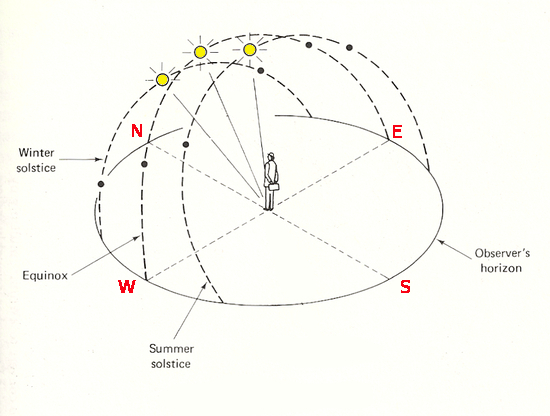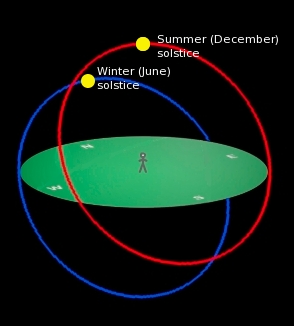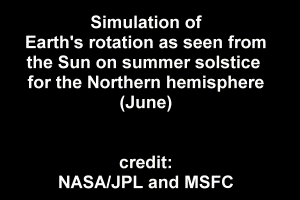Happy June solstice, folks!
But, um, what exactly is a solstice? That font of all knowledge, Wikipedia, says:
“The word solstice is derived from the Latin sol (sun) and sistere (to stand still).”
But of course the Sun doesn’t literally stand still. So what DOES it do?
Back to the Sun.
Imagine you’re a garden gnome in Australia, standing outside looking north all the time. This is what you’ll see at different times of year.
What a north-facing Australian garden gnome would see.
Adapted from http://solarwiki.ucdavis.edu/@api/deki/files/175/
In summer the Sun rises early and makes a long trek across the sky, going way overhead. In winter the Sun gets up late, creeps low across the sky, and sets early.
The extreme cases are the solstices, summer and winter, which in the southern hemisphere occur in December and June respectively.
At the winter (June) solstice, the sun reaches its maximum northerly point then starts to head south again. That maximum northerly point is the “standing still” bit.
Why this happens
OK, so this is what you see on the ground. Why does it happen?
The first picture showed how you how the Sun goes across the sky at the summer and winter solstice. Now let’s extend those tracks right around the Earth. The blue circle at the back is the Sun’s winter solstice track, and the red one at the front is its summer solstice track.
Of course, the Sun doesn’t really zip round the Earth like this — the Earth spins on its axis. But just for the moment, let’s think of how the Sun seems to move.
The tracks of the Sun at the winter and summer solstices, for an observer at the latitude of Sydney, Australia.
Created with the simulator at http://astro.unl.edu/classaction/animations/coordsmotion/sunmotionsoverview.html .
Now let’s zoom out into space and see how one of those circles — the winter (June) solstice path — is created. Play the video:
[Source: YouTube video.]
The orange line shows where the Sun would go overhead as the Earth rotates. If you were standing anywhere on this line at the June solstice, the Sun would come up, go right overhead, and then set.
Notice how, with the Sun going overhead in the northern hemisphere, the North Pole is enjoying constant daylight, while the South Pole and regions around it are always in the dark.
If you were the Sun, what would you see? NASA has done the imagining for you.
The Earth, seen from the Sun’s position, at the time of a June solstice.
Source: NASA (http://science.nasa.gov/science-news/science-at-nasa/2000/solstice/)
The Sun has a nice view of the northern hemisphere, but it’s seeing the southern hemisphere at an angle — and it’s not even glimpsing the South Pole.
So that’s the winter (June) solstice. Of course, when the Sun reaches its southernmost point in December, everything is reversed, and we get the summer (December) solstice.
Why does the Sun “move” north and south at all? Because the Earth’s axis is tilted. But you already knew that …
In June, the Earth’s northern hemisphere is tilted towards the Sun. In December, the southern hemisphere is.
[Derived from a NASA diagram: http://scijinks.nasa.gov/solstice .]







21st June 2013 at 1:29 pm
Reblogged this on News @ CSIRO and commented:
Here’s a great explainer on why today is the shortest day of the year from our Universe@CSIRO blog. The best thing about the winter solstice is that the days get longer from here… until the summer solstice, that is.